th (I'm guessing the letters stand for Turbine Hall) continues the love song to David Bowie that flowered in 2009's come, been and gone, and recycles quite a bit of that work, with the dubious new ingredient of 50 amateur volunteers brought in off the street last autumn as a community experiment. Split in two halves, created to seven Bowie songs with three more by Jarvis Cocker and Kraftwerk, th counterpoints the ordinary Joes, pinned and belted into fluffy black towels, against 13 trained dancers in sleek leotards. The towels give a puzzling air of Roman togas, while the portentous programme note states that Clark wants to invoke militarised societies and mass social actions.
My eye. I bet someone else wrote that. Anyway, there are several things wrong with this as a performance experience. First, the towels show much of the natural flobbiness of ordinary Joe legs and the volunteers know it and look generally embarrassed; second, their drills are too elementary to have much symbolic resonance; and third, they can’t even do them in sync, so there is nothing to be pondered sociologically other than why the audience screams with acclaim for their paltry efforts. (Now that's a social comment worth making, how easily audiences today think three “dance” steps is some kind of miracle.)
On the other hand, the real dancers are as sleek as seals in their second skins: their leotards change from white and black, to silver and black, to silvery orange - the last ones lighting up the dinge of the Turbine Hall something splendid. Their choreography is, as has become familiar with Clark, made up of short routines of extremely tight-arsed ballet, legs and thighs obsessively turned out, feet obsessively pointed, and with much-repeated v-e-r-y slow walking. There’s no sign yet of Clark lightening up on the hands, which remain as usual jagged as shards of glass, and the heads on the dancers’ stiff necks remain almost robotically unyielding, eyes forward, all thoughts shuttered.
I’ve been seeing this Clark signature for too long now to find it enigmatic any more - I long for a little bit of the cackle, individualism and almost holy worship of ballet’s ritual language that his great youthful pieces went in for. In the past decade that risky, psychedelic theatricality has become austerely chic, cleaned up, it’s become a script of balletic hieroglyphs, more powerful I think when read flattened on a proscenium stage, like writing on a page, than in-the-round.
Where Cunningham’s dancers would enter, flock and leave like naturally forming organisms, Clark’s seem to be placed into the stage - over here, over there, a couple in the middle. The encounters lack linking threads. The audience’s heads swing from side to side, left, right, left, right, more worried about missing something than able to fasten on a long phrase, or a sequence passing motion back and forth.
Listen to David Bowie's "Sweet Thing/Candidate"
Still, there are two or three marvellous points. In a sequence to "Sweet Thing/Candidate" (see AV above), a beautiful boy alone in the middle, spotlit in the dark, does those achingly slow, succulently thorough stretches and rolls that the boy Clark used to be glorified for, echoing the self-absorption of Jerome Robbins’s Faun - suddenly you become aware that across to the side three other men are watching this Adonis, one working at his own barre, two others upstairs on a balcony. The lad notices them, crosses to the barre, and the electric moment dissipates in work. It’s a magically erotic exploitation of the mystery of dark space between lights.

In another, the "Heroes" sequence, we see a film of David Bowie, compellingly closing in on his mischievous, seductive clown face and his vividly shifting, capriciously expressive body, while across the hall two or three dancers in black offer a steady live counterpoint. Spectator heads swivel towards the live dancers, but in the dark under the film screen as Bowie closes in foetal huddle on the ground, you could make out Clark himself in a hoodie, in an echoing sequence of Bowie/Faun-like stretches in which I thought he was looking at himself in a mirror (or iPad?). This Narcissus in the dark was a fascinating ephemera, a glimpse of a parallel world, and something so deceptive I wondered if I’d actually seen it. Is Clark's storyteller side preparing to re-emerge?
The joyfully strutting Jean Genie ballet-meets-salsa finale has been seen a couple of times before in other Clark pieces but those Stevie Stewart costumes (pictured right) remain the most exultantly saucy outfits you'll ever see on a ballet body.
- Michael Clark's th is at the Tate Modern, London, till Sunday
- Company website here

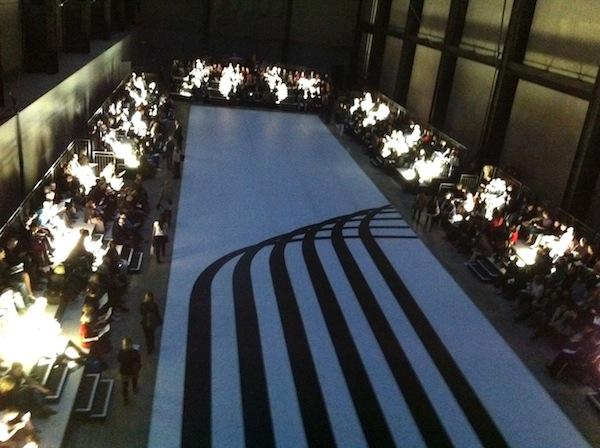

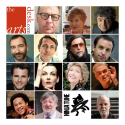
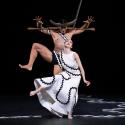








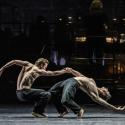
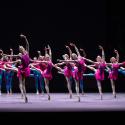
Add comment